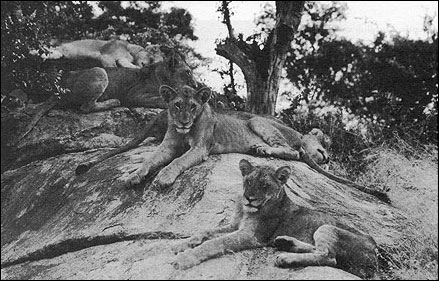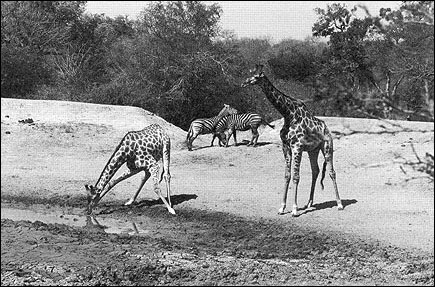
On the morning of my wife’s birthday in 2003, we found this pride of lions—14 in all—draped on a rock right next to the road. The exceptional scene seemed to be choreographed by an expert. The lions patiently allowed us to photograph them from all sides before slowly getting up, stretching and sauntering away into the bush. Photo by Hennie van Deventer.
Being an expert with a camera is not required to take great wildlife photographs in South Africa’s famous Kruger National Park in the province of Mpumalanga. Amazing opportunities present themselves regularly. On a day trip through the reserve a visitor can expect to encounter a large diversity of species and at least two or three of the “big five”—lion, leopard, elephant, rhino and buffalo. Those most fortunate score five out of five.
A decent camera is required, but also valuable are alertness, patience and perseverance—three qualities I have learned the hard way since 1998, the year of my retirement from journalism. At first many prize photographs escaped me as a result of my hasty journalistic nature and lack of bush awareness. Then I toned down and refocused, changing my lifestyle to suit the slower heartbeat of the African bush. Not only did my quality of life immediately improve, but also the quality of my photographs.
Although strictly an amateur, I am thrilled to have the walls of our bush cottage in Sabiepark, a private reserve neighboring the Kruger, be adorned with dozens of special wildlife images. These pictures include members of the big five and also stately giraffe, graceful impala, quaint wildebeest, plump zebra drinking at water holes and cheetah and hyena on the prowl. There are a fistful of many impressive birds, too, and all of these were shot with my Canon EOS 500N fitted with a flash and a modest 75-300 zoom. I often rely on automatic mode. As far as film is concerned, experience has taught me that 100ASA film is a good all-round choice. It is, however, advisable to carry a couple of rolls of faster (400) film as well, for dull conditions or to get extra reach for flash photography at night.
The van Deventer cottage, dark brick and thatched, is less than two miles from the Kruger gate and only 10 miles from Skukuza, the main rest camp. One of the unique perks of living in Sabiepark is the opportunity for quick visits to Skukuza or short, concentrated drives along the Sabie River, with its lush growth. A “wild card” at a bargain price offers unlimited entry—and adventure. On the short stretch to Skukuza we have come across lion kills, angry elephants, or vast herds of buffalo blocking the traffic for hours, even giraffe making love—a rather complicated, hasty affair. On the other hand, on quiet days we have driven for hours without sighting anything special. It’s the luck of the draw. We know that, and we never complain.
Hennie van Deventer, a 1977 Nieman Fellow, was chief executive of Newspapers of Naspers in Cape Town, South Africa from 1992 until his retirement in February 1999. Previously he edited Die Volksblad in Bloemfontein for 12 years. In 1997 he was awarded the Phil Weber gold medal, the highest honor bestowed by Naspers, for sustained performance in a career spanning 35 years. He is also the author of six books.

A magnificent leopard awakens in a tree, ready for the night’s activities. This feline mammal, usually sporting a tawny yellow coat with black rosette-like spots, represents one of the great sights of the African bush. For many visitors, encountering a leopard is more exciting than coming upon a lion.

Impala, a smallish antelope with lyre-shaped horns, have the ability to move with enormous, yet very graceful leaps when disturbed. Thousands of them roam Kruger Park. The name “impala” comes from the Zulu language.

A white rhino appears menacingly from the bush. This powerful animal, with its massive body, two horns on its nose, very thick skin, and three digits on each foot is a real danger when provoked. The black rhino is even more aggressive, but smaller. Both white and black rhinos are considered members of the big five.

It takes time and patience for a thirsty giraffe to get the legs, front and back, in exactly the right position. And it must not be easy on the nerves to stand stretched in such a vulnerable way. Finally settled to enjoy a drink, this giraffe withdrew a moment after the photo was taken; evidently the muddy pool had a foul taste or smell.
Photos by Hennie van Deventer.


